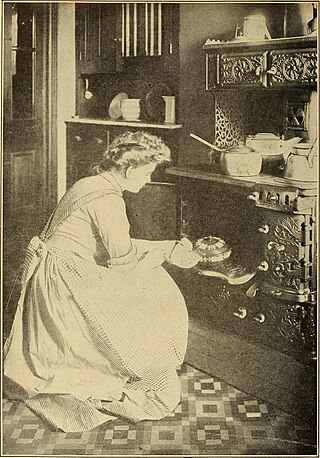
Parental leave, or family leave, is an employee benefit available in almost all countries. The term "parental leave" may include maternity, paternity, and adoption leave; or may be used distinctively from "maternity leave" and "paternity leave" to describe separate family leave available to either parent to care for small children. In some countries and jurisdictions, "family leave" also includes leave provided to care for ill family members. Often, the minimum benefits and eligibility requirements are stipulated by law.
Feminization of poverty refers to a trend of increasing inequality in living standards between men and women due to the widening gender gap in poverty. This phenomenon largely links to how women and children are disproportionately represented within the lower socioeconomic status community in comparison to men within the same socioeconomic status. Causes of the feminization of poverty include the structure of family and household, employment, sexual violence, education, climate change, femonomics and health. The traditional stereotypes of women remain embedded in many cultures restricting income opportunities and community involvement for many women. Matched with a low foundation income, this can manifest to a cycle of poverty and thus an inter-generational issue.

Sociology of the family is a subfield of the subject of sociology, in which researchers and academics study family structure as a social institution and unit of socialization from various sociological perspectives. It can be seen as an example of patterned social relations and group dynamics.

A double burden is the workload of people who work to earn money, but who are also responsible for significant amounts of unpaid domestic labor. This phenomenon is also known as the Second Shift as in Arlie Hochschild's book of the same name. In couples where both partners have paid jobs, women often spend significantly more time than men on household chores and caring work, such as childrearing or caring for sick family members. This outcome is determined in large part by traditional gender roles that have been accepted by society over time. Labor market constraints also play a role in determining who does the bulk of unpaid work.
The gender pay gap in the United States is a measure between the earnings of male and females in the workforce. When calculating the pay gap, non-adjusted versus adjusted pay gap is utilized. The adjusted pay gap takes into consideration the differences in hours worked, occupations chosen, education and job experience, whereas the non-adjusted pay gap is the overall difference of gross hourly earnings of males and females in the United States. The non-adjusted average female annual salary is around 80% of the average male salary, compared to 95% for the adjusted average salary.
A mommy track is a path in a woman's life that puts priority to being a mother. It can also specifically refer to work arrangements for women in the workforce that facilitate motherhood, such as flexible hours, but at the same time usually provides fewer opportunities for career advancement. References to the mommy track often go along with being a housewife, "opting out" of the workforce, temporarily or even permanently. Women following the mommy track may be contrasted to career women who prioritize their careers more than having children.

Since the industrial revolution, participation of women in the workforce outside the home has increased in industrialized nations, with particularly large growth seen in the 20th century. Largely seen as a boon for industrial society, women in the workforce contribute to a higher national economic output as measure in GDP as well as decreasing labor costs by increasing the labor supply in a society.
Gender inequality is the social phenomenon in which people are not treated equally on the basis of gender. This inequality can be caused by gender discrimination or sexism. The treatment may arise from distinctions regarding biology, psychology, or cultural norms prevalent in the society. Some of these distinctions are empirically grounded, while others appear to be social constructs. While current policies around the world cause inequality among individuals, it is women who are most affected. Gender inequality weakens women in many areas such as health, education, and business life. Studies show the different experiences of genders across many domains including education, life expectancy, personality, interests, family life, careers, and political affiliation. Gender inequality is experienced differently across different cultures and also affects non-binary people.
Occupational inequality is the unequal treatment of people based on gender, sexuality, height, weight, accent, or race in the workplace. When researchers study trends in occupational inequality they usually focus on distribution or allocation pattern of groups across occupations, for example, the distribution of men compared to women in a certain occupation. Secondly, they focus on the link between occupation and income, for example, comparing the income of whites with blacks in the same occupation.

Unpaid labor or unpaid work is defined as labor or work that does not receive any direct remuneration. This is a form of non-market work which can fall into one of two categories: (1) unpaid work that is placed within the production boundary of the System of National Accounts (SNA), such as gross domestic product (GDP); and (2) unpaid work that falls outside of the production boundary, such as domestic labor that occurs inside households for their consumption. Unpaid labor is visible in many forms and isn't limited to activities within a household. Other types of unpaid labor activities include volunteering as a form of charity work and interning as a form of unpaid employment. In a lot of countries, unpaid domestic work in the household is typically performed by women, due to gender inequality and gender norms, which can result in high-stress levels in Women attempting to balance unpaid work and paid employment. In poorer countries, this work is sometimes performed by children.
The breadwinner model is a paradigm of family centered on a breadwinner, "the member of a family who earns the money to support the others." Traditionally, the earner works outside the home to provide the family with income and benefits such as health insurance, while the non-earner stays at home and takes care of children and the elderly. The breadwinner model largely arose in western cultures after industrialization occurred. Before industrialization, all members of the household—including men, women, and children—contributed to the productivity of the household. Gender roles underwent a re-definition as a result of industrialization, with a split between public and private roles for men and women, which did not exist before industrialization.
Work–family balance in the United States differs significantly for families of different social class. This differs from work–life balance: while work–life balance may refer to the health and living issues that arise from work, work–family balance refers specifically to how work and families intersect and influence each other.
Shared earning/shared parenting marriage, also known as peer marriage, is a type of marriage where partners at the outset agree to adhere to a model of shared responsibility for earning money, meeting the needs of children, doing household chores, and taking recreation time in near equal fashion across these four domains. It refers to an intact family formed in the relatively equal earning and parenting style from its initiation. Peer marriage is distinct from shared parenting, as well as the type of equal or co-parenting that father's rights activists in the United States, the United Kingdom and elsewhere seek after a divorce in the case of marriages, or unmarried pregnancies/childbirths, not set up in this fashion at the outset of the relationship or pregnancy.
The motherhood penalty is a term coined by sociologists who argue that in the workplace, working mothers encounter disadvantages in pay, perceived competence, and benefits relative to childless women. Specifically, women may suffer a per-child wage penalty, resulting in a pay gap between non-mothers and mothers that is larger than the gap between men and women. Mothers may also suffer worse job-site evaluations indicating that they are less committed to their jobs, less dependable, and less authoritative than non-mothers. Thus, mothers may experience disadvantages in terms of hiring, pay, and daily job experience. The motherhood penalty is not limited to one simple cause but can rather be linked to many theories and societal perceptions. However, one prominent theory that can be consistently linked to this penalty is the work-effort theory. It is also based on the mother's intersectionality. There are many effects developed from the motherhood penalty including wage, hiring, and promotion penalties. These effects are not limited to the United States and have been documented in over a dozen other industrialized nations including Japan, South Korea, The United Kingdom, The Netherlands, Poland, and Australia. The penalty has not shown any signs of declining over time.

In 2021, China ranked 48th out of 191 countries on the United Nations Development Programme's Gender Inequality Index (GII). Among the GII components, China's maternal mortality ratio was 32 out of 100,000 live births. In education 58.7 percent of women age 25 and older had completed secondary education, while the counterpart statistic for men was 71.9 percent. Women's labour power participation rate was 63.9 percent, and women held 23.6 percent of seats in the National People's Congress. In 2019, China ranked 39 out of the 162 countries surveyed during the year.
In South Korea, gender inequality is derived from deeply rooted patriarchal ideologies with specifically defined gender-roles. While it remains especially prevalent in South Korea's economy and politics, gender inequality has decreased in healthcare and education.

The gender pay gap or gender wage gap is the average difference between the remuneration for men and women who are working. Women are generally found to be paid less than men. In the United States, for example, the average annual salary of a woman is 83% that of a man. However, this figure changes when controlled for confounding factors such as differences in hours worked, occupations chosen, education, job experience, and level of danger at work, which has adjusted figures in the United States from 95% to 99%. At the global level, the World Health Organization has estimated women healthcare workers earn 28% less on average than men; after adjusting for occupation and hours worked, the gap is changed to 11%.
The maternal wall is a term referring to stereotypes and various forms of discrimination encountered by working mothers and mothers seeking employment. Women hit the maternal wall when they encounter workplace discrimination because of past, present, or future pregnancies or because they have taken one or more maternity leaves. Women may also be discriminated against when they opt for part-time or flexible work schedules. Maternal wall discrimination is not limited to childcare responsibilities. Both men and women with caregiving responsibilities, such as taking care of a sick parents or spouse, may also result in maternal wall discrimination. As such, maternal wall discrimination is also described as family responsibilities discrimination. Research suggests that the maternal wall is cemented by employer stereotypes and gender expectations.
Gender pay gap in India refers to the difference in earnings between women and men in the paid employment and the labor market. For the year 2013, the gender pay gap in India was estimated to be 24.81%. Further, while analyzing the level of female participation in the economy, this report slots India as one of the bottom 10 countries on its list. Thus, in addition to unequal pay, there is also unequal representation, because while women constitute almost half the Indian population, their representation in the work force amounts to only about one-fourth of the total.
Even as a highly developed and modern society, Japan still has moderate levels of gender inequality. In 2015, the country had a per-capita income of US$38,883, ranking 22nd of the 188 countries, and No. 18 in the Human Development Index. Its Gender Inequality Index rank was 17th on the 2019 report ahead of Germany, the UK and the US, performing especially well on the reproductive health and higher education attainment indices. Despite this, gender inequality still exists in Japan due to the persistence of gender norms in Japanese society. Gender-based inequality manifests in various aspects of social life in Japan, from the family to political representation, playing particular roles in employment opportunities and income, and occurs largely as a result of differing gender roles in traditional and modern Japanese society. Inequality also lies within divorce and the marriage of same sex couples due to both a lack of protective divorce laws and the presence of restrictive marriage laws; discrimination exists outside of the law and is present in the modern day society of Japan.







